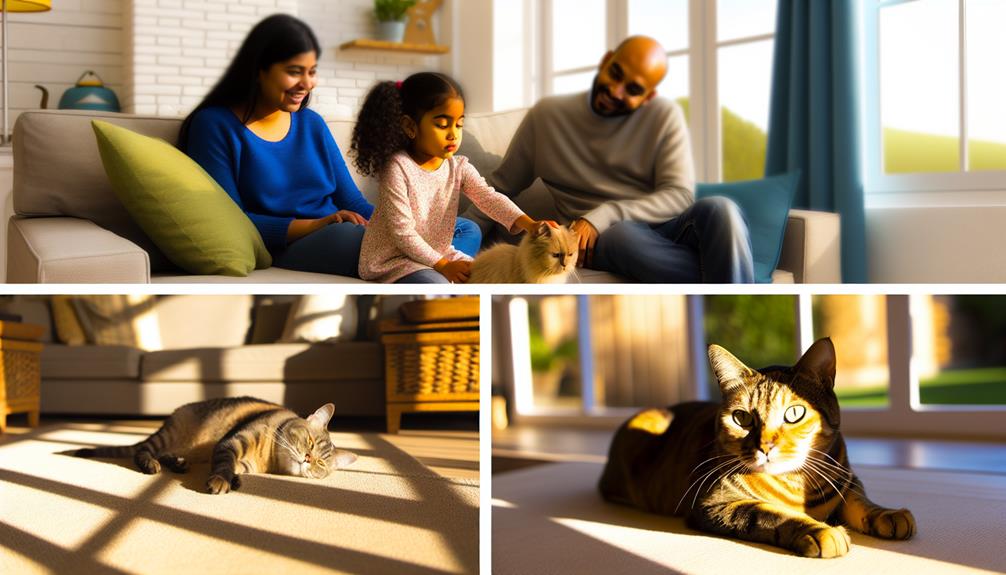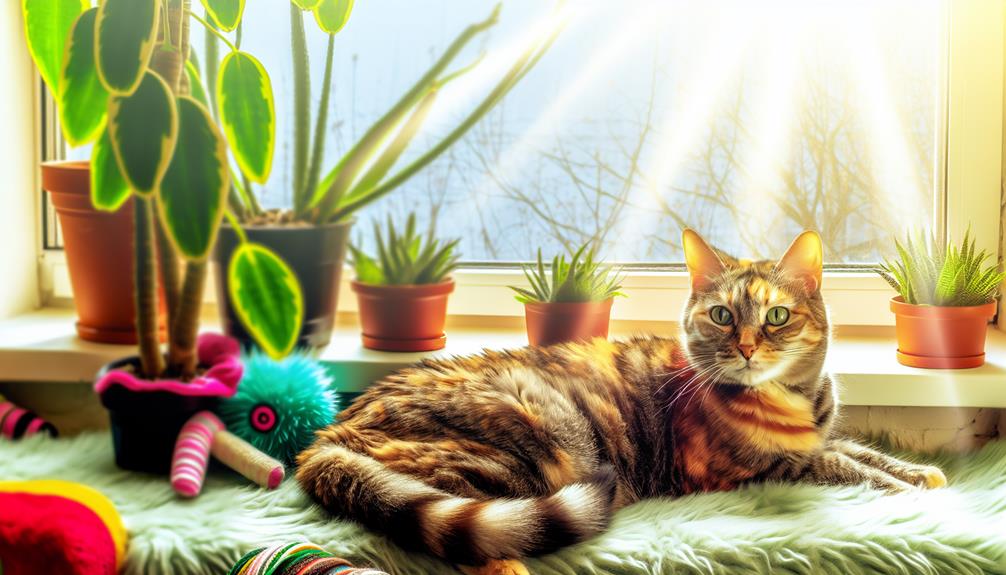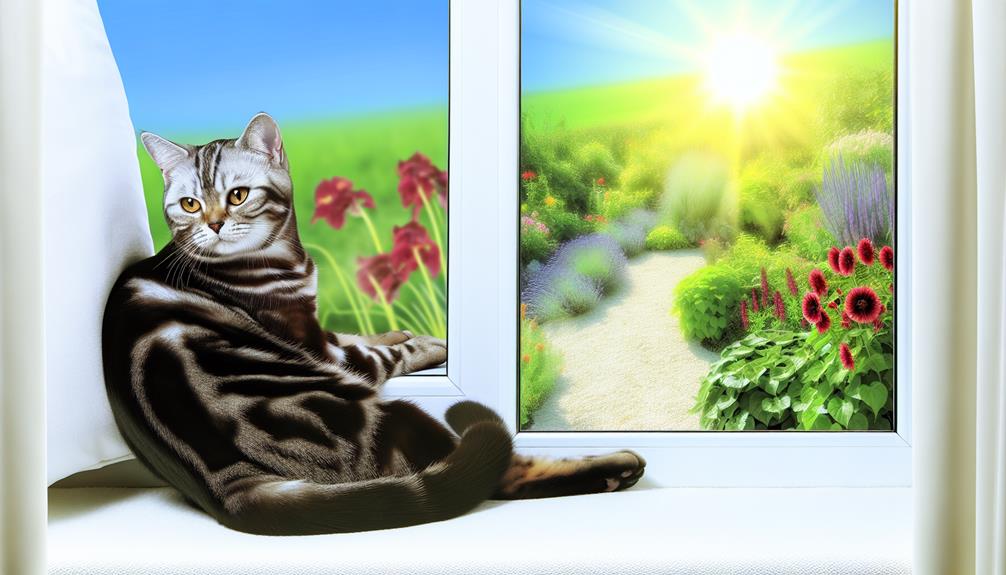Just as a mosaic combines diverse pieces into a unique work of art, the term "Domestic Shorthair" epitomizes the beauty of mixed breed shorthaired cats. You might wonder why these felines, without a specific pedigree, are so cherished by cat enthusiasts. The answer lies not just in their vibrant array of coat patterns and colors, but also in their remarkable health and adaptability. Imagine a cat that fits perfectly into almost any home environment—sounds ideal, doesn't it? Let's explore why these cats hold a special place in so many hearts.
Terminology Explained
Understanding the terminology surrounding mixed breed shorthaired cats can greatly enhance your knowledge and appreciation of these diverse felines. When you explore mixed breed terminology, it's essential to grasp the basics of feline genetics. Mixed breed shorthaired cats, often referred to as domestic shorthairs (DSH), don't belong to a specific breed but rather represent a blend of various genetic backgrounds. This genetic diversity can result in a wide range of physical traits and temperaments.
In the domain of feline genetics, the term "mixed breed" indicates that a cat's lineage includes ancestors from multiple breeds. Unlike purebred cats, which have a documented pedigree, mixed breed cats lack such a detailed lineage. This lack of a specific breed history contributes to their genetic variability. You'll find that mixed breed shorthaired cats can exhibit a vast array of coat colors, patterns, and body types due to the diverse genetic pool from which they come.
Another key term to understand is "phenotype," which refers to the observable characteristics of an organism resulting from the interaction of its genotype (genetic makeup) with the environment. In mixed breed shorthaired cats, phenotypic variations are common, as the interplay of genes from different breeds can produce unique and unpredictable outcomes.
Common Characteristics
When considering the common characteristics of mixed breed shorthaired cats, you'll notice a variety of coat patterns and colors that add to their unique appeal. Their temperament and behavior can vary widely, influenced by their diverse genetic backgrounds. Additionally, these cats tend to exhibit a broad range of health profiles and lifespans, reflecting their mixed heritage.
Coat Patterns and Colors
The allure of mixed breed shorthaired cats often lies in their diverse coat patterns and colors, which can range from solid hues to intricate tabby stripes and striking tortoiseshell blends. This vast array of coat variations is primarily driven by the complex interplay of color genetics. Understanding these genetic factors can help you appreciate the unique beauty of each mixed breed shorthaired cat.
Color genetics in cats are fascinating, with numerous genes interacting to produce various patterns and shades. Here are some common coat patterns and colors you might encounter:
- Solid Colors: These cats have fur of a single, uniform color, such as black, white, or gray, resulting from a lack of pattern genes.
- Tabby Patterns: Tabby cats display a variety of stripes, spots, or swirls, often with an "M" shape on their foreheads, and their patterns are influenced by the agouti gene.
- Tortoiseshell: These cats exhibit a mottled blend of black, orange, and sometimes white, due to the interaction of sex-linked genes.
- Calico: Similar to tortoiseshells but with distinct patches of orange, black, and white, calico cats result from the same genetic factors but with different expression.
Temperament and Behavior
Often endearing and adaptable, mixed breed shorthaired cats exhibit a range of temperaments and behaviors that reflect their diverse genetic backgrounds. These cats are typically known for their playful nature, which can be a delightful source of entertainment. Their playfulness traits often include a fondness for interactive toys and engaging in games of chase, which can help keep them mentally stimulated and physically active.
To guarantee well-rounded behavior, socialization tips are vital. Introducing your cat to various environments, people, and other animals from a young age can greatly influence their sociability and comfort levels. This exposure helps in mitigating potential behavioral issues such as timidity or aggression.
Mixed breed shorthaired cats can also display a wide spectrum of social tendencies. While some may be highly affectionate and enjoy constant companionship, others might prefer a more independent lifestyle. Understanding your cat's unique personality will enable you to foster a supportive and nurturing environment.
Health and Lifespan
Understanding the health and lifespan of mixed breed shorthaired cats requires a thorough look at their genetic diversity, which can be both an advantage and a challenge. Genetic diversity often means that mixed breed cats have a broader gene pool, potentially reducing the likelihood of inheriting genetic disorders that are common in purebred counterparts. However, this same diversity can make it difficult to predict specific health outcomes.
Common ailments in these cats can vary widely, but some general issues may still arise. Here are a few to be aware of:
- Dental Disease: Regular dental check-ups are vital to prevent gum disease and tooth loss.
- Obesity: Mixed breed shorthaired cats can be prone to weight gain, making a balanced diet essential.
- Urinary Tract Issues: This can be a problem, especially in male cats, so ample hydration is important.
- Allergies: Skin and food allergies can be common, requiring a tailored approach to diet and environment.
On average, mixed breed shorthaired cats can live between 12 to 16 years, depending on their care and environment. Regular veterinary visits, a balanced diet, and adequate exercise can greatly contribute to their overall health and longevity.
Adoption Benefits

Adopting a mixed breed shorthaired cat offers numerous benefits, both for you and the feline companion. The adoption process itself is often straightforward and designed to match you with a pet that fits your lifestyle. Shelters provide an essential service by housing these cats, many of whom have been abandoned or surrendered due to circumstances beyond their control. By adopting, you're not just gaining a new pet; you're also helping to alleviate the overcrowding in shelters and giving a deserving cat a second chance at a loving home.
Mixed breed shorthaired cats are typically robust and adaptable. They often exhibit fewer genetic health issues compared to purebred counterparts, thanks to their diverse gene pool. This can lead to lower veterinary costs over the lifetime of the pet. Additionally, these cats are usually well-socialized, having been exposed to various environments and people during their time in the shelter. They're likely to adjust more easily to your home and routine, making the change smoother for both you and the cat.
Moreover, the emotional rewards of adopting a shelter cat can't be overstated. Knowing you've given a cat a new lease on life adds a layer of satisfaction and mutual affection to the relationship. You'll also find that shelters often provide support post-adoption, offering resources and advice to guarantee a successful integration of the cat into your home. This support network can be invaluable, particularly for first-time pet owners.
Care Tips
After bringing your newly adopted mixed breed shorthaired cat home, ensuring its well-being and happiness becomes your next priority. Proper care involves understanding specific grooming techniques and adhering to feeding guidelines tailored to your cat's unique needs.
Grooming techniques for shorthaired cats are relatively straightforward but still fundamental. Regular brushing helps reduce shedding and prevents hairballs, ensuring your cat's coat remains healthy and shiny. Aim to brush your cat at least once a week, using a soft-bristle brush to avoid skin irritation. Bathing should be infrequent, as cats are naturally adept at self-cleaning. When necessary, use a gentle cat-specific shampoo.
Feeding guidelines are equally vital for maintaining your cat's health. Mixed breed cats can vary in size and activity levels, so it's important to select a high-quality cat food that meets their nutritional needs. Generally, split their daily food intake into two meals to help manage weight and prevent overeating. Always provide fresh water, and avoid feeding them human food, which can lead to obesity and other health issues.
For a harmonious living environment, consider these additional tips:
- Regular Vet Visits: Schedule annual check-ups to monitor health and address any potential issues early.
- Interactive Play: Engage in daily play sessions to stimulate your cat mentally and physically.
- Litter Box Maintenance: Keep the litter box clean, scooping daily and changing the litter weekly.
- Safe Spaces: Provide hiding spots and perches for your cat to retreat to when they need to feel secure.
Popular Mixed Breeds

When exploring popular mixed breeds, you'll find that Domestic Shorthairs are known for their robust health and diverse appearances. Tuxedo cats, with their striking black and white coats, offer a unique blend of charm and elegance. Additionally, Tabby mixes are celebrated for their distinctive striped patterns and friendly dispositions.
Domestic Shorthair Traits
Stepping into the world of Domestic Shorthair traits, you'll quickly discover why these cats are beloved among pet owners. Known for their adaptability and robust health, Domestic Shorthairs are a popular choice for families and individuals alike. Understanding their grooming needs and activity levels is essential to providing the best care for these versatile companions.
Domestic Shorthairs generally have low grooming needs due to their short, dense coats. A weekly brushing session will keep their fur in good condition and reduce shedding. Their coats can come in a variety of colors and patterns, adding to their widespread appeal.
When it comes to activity levels, Domestic Shorthairs are known for their playful and energetic nature. They enjoy interactive play and require mental stimulation to stay happy and healthy. You can keep them engaged with toys, climbing structures, and regular playtime.
Here are some key traits:
- Adaptability: They adjust well to various living environments, making them ideal for both apartments and houses.
- Health: Generally robust, they have fewer genetic issues compared to purebred counterparts.
- Sociability: These cats are friendly and often get along well with children and other pets.
- Intelligence: Highly intelligent, they quickly learn new tricks and adapt to routines.
Tuxedo Cat Characteristics
Among the various mixed breeds, the Tuxedo cat stands out for its distinctive black and white coat, reminiscent of formal wear. This striking coloration isn't limited to any specific breed; rather, it's a pattern that can appear in a variety of mixed breed shorthaired cats. The Tuxedo cat's history is rich and varied, dating back to ancient Egypt where depictions of similarly patterned cats have been found in tombs and artwork. These cats were often associated with protection and good luck.
Tuxedo cats are surrounded by numerous legends and myths. One such legend claims that they possess a magical ability to bring good fortune to their owners. Another popular belief is that Tuxedo cats are more intelligent and capable than their feline counterparts, a theory often supported by anecdotal evidence rather than scientific data.
From an analytical perspective, Tuxedo cats exhibit a range of temperaments, making them suitable for various households. Their striking appearance isn't just about aesthetics; it's also a conversation starter, adding to their charm and appeal. Whether you're interested in their storied past or the legends that surround them, Tuxedo cats are truly unique members of the mixed breed shorthaired category.
Tabby Mix Features
A fascinating aspect of mixed breed shorthaired cats is the Tabby mix, which showcases a variety of enchanting features and patterns. These cats are known for their distinctive tabby markings, which are determined by specific tabby genetics. Understanding these genetic influences can help you appreciate the unique beauty and diversity found in Tabby mixes.
Tabby mixes often exhibit a combination of the following features:
- Mackerel Markings: These resemble a fish skeleton with narrow, parallel stripes running down their sides.
- Classic Swirls: Also known as the "blotched" pattern, this includes bold, swirling patterns on their bodies.
- Spotted Patterns: These cats have spots distributed across their coats, often giving a wild, exotic appearance.
- Ticked Coats: Each hair shaft features alternating bands of color, creating a salt-and-pepper look.
These distinct tabby markings are not just about aesthetics. They also provide insights into the cat's ancestry and the complex interplay of tabby genetics. When you encounter a mixed breed shorthaired cat with these features, you're seeing a blend of inherited traits that have adapted over time. Recognizing these characteristics allows you to better understand and appreciate the rich tapestry of feline genetics that shapes the Tabby mix.
Myths and Facts
Dispelling myths surrounding mixed breed shorthaired cats is essential for pet owners and enthusiasts alike. One of the most common breeding misconceptions is that mixed breed cats are less healthy than their purebred counterparts. In reality, feline genetics play a significant role in determining a cat's health, and mixed breed cats often benefit from greater genetic diversity, which can reduce the risk of hereditary diseases.
Another widespread myth is that mixed breed shorthaired cats lack the desirable traits found in purebred cats. This notion is unfounded, as feline genetics are complex and not limited to specific breeds. Mixed breed cats can exhibit a wide range of physical and personality traits, often making them unique and diverse companions.
To help you understand better, let's break down some common myths and the corresponding facts:
| Myth | Fact |
|---|---|
| Mixed breed cats are less healthy | Genetic diversity often leads to fewer hereditary diseases |
| Lacking desirable traits of purebreds | Mixed breeds can have a wide range of appealing traits |
| Harder to train or less intelligent | Intelligence and trainability vary individually and are not breed-specific |
| Shorter lifespan compared to purebreds | Life expectancy is influenced by care, not breed purity |
Furthermore, the myth that mixed breed shorthaired cats are harder to train or less intelligent is simply not true. Intelligence and trainability are individual traits and are not confined to specific breeds.
Lastly, the idea that mixed breed cats have a shorter lifespan compared to purebreds is another misconception. A cat's life expectancy is influenced more by the care it receives than its breed purity. Understanding these myths and facts helps you make informed decisions and appreciate the unique qualities of mixed breed shorthaired cats.
Conclusion
In sum, a mixed breed shorthaired cat is called a Domestic Shorthair (DSH). You'll find them adaptable and resilient, healthy and diverse, unique and personable. Adopting a DSH offers you a robust, low-maintenance companion. Caring for them is straightforward, but always rewarding. Whether you're drawn to their varied appearances or their versatile temperaments, there's a DSH to suit every home. Embrace the joy, embrace the diversity, and embrace the companionship a Domestic Shorthair brings.
